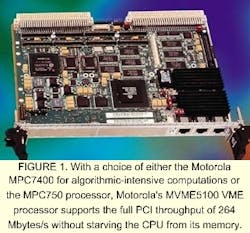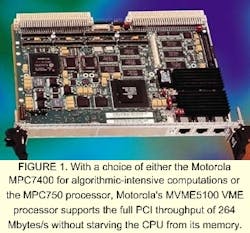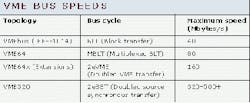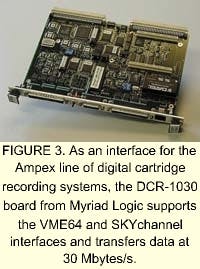VME imaging boards set to improve multiprocessing
For demanding tasks, vendors are readying VME-based frame-grabber/image-processing boards with high-speed interfaces.
By Andrew Wilson,Editor
Many of today's machine-vision tasks require the acquisition of images from area-array or linear cameras to be processed rapidly. To meet this demand, several board-level PC vendors offer integrated frame-grabber/image-processing boards that combine on-board analog-to-digital converter, look-up-table, memory, processing, and display capabilities. Although these products satisfy the demands of processing video-resolution-sized images at high speeds, they are often not suited to capturing and processing the very-high-resolution images needed for medical and military applications.
Systems that digitize x-rays in nuclear-magnetic-resonance or airport baggage-inspection systems, for example, often require multiple images of 4k x 4k x 12 bits to be stored and processed quickly. To meet these needs, systems integrators generally avoid using a PC; they prefer the added bandwidth, processing power, and software-development tools of VME-based systems.
Choosing which boards to implement in such systems, however, is more complex than PC-based systems design. Not only must systems integrators decide which boards best fit their application, but they must also understand how VME-board vendors plan to upgrade their products to offer more efficient multiprocessing capability (see Vision Systems Design, April 2000, p. 39).
VME developments
Like the PCI bus, the VME bus was developed to allow numerous boards from a variety of vendors to operate together. Indeed, all legacy VME and VME64 modules are forward compatible to the latest VME64x backplanes and subracks so that older bus modules can be plugged into newer systems. The current data rate of 160 Mbytes/s used by the VME64x standard has evolved from the bus's initial 40-Mbyte/s data rate to the present widely adopted VME standard (see table on p. 42).
Despite such developments, companies supporting the VME64x specification are hard to find. Although the standard was ratified more than three years ago, there are no VME products available that claim conformance to this standard. A major reason for this lack of support has been the scarcity of VME interface ICs. Those that are available, such as the Universe II from Tundra Semiconductor (Kanata, Ont., Canada) and the ALMA-V64 from IBM (Armonk, NY), are designed to interface a VME64 bus with a 32-bit PCI bus.
The MVME5100 VME processor module from the Motorola Computer Group (MCG; Tempe, AZ) is a good example of these products (see Fig. 1). Offering a choice of either Motorola's MPC7400 for algorithmic-intensive computations or the MPC750 processor, the VME64 board is based on an integrated PCI bridge-memory controller ASIC designed by the MCG. According to Motorola, the board supports full PCI throughput of 264 Mbytes/s without starving the CPU from its memory.
I/O extensions
To increase data-transfer speeds between processors on single boards and between board-based systems, Mercury Computer (Chelmsford, MA), Sky Computers (Chelmsford, MA), and CSPI (Billerica, MA) have all developed or endorsed separate input/output (I/O) specifications. Whereas Mercury's RACEway and RACE++ interconnects offer maximum data bandwidths of 160 and 267 Mbytes, respectively, the SKYchannel interconnect is capable of delivering 320 Mbytes/s. CSPI, choosing to endorse the Myrinet system-area network (SAN) standard from Myricom (Arcadia, CA), boasts a 320-Mbyte/s per SAN link using 80-MHz low-voltage differential signaling (LVDS) technology.
Although Mercury, Sky, and CSPI manufacture CPU-based systems, they generally rely on third-party VME vendors to supply image-capture, display, and storage capabilities. To take advantage of the benefits offered by RACEway, SKYchannel, and Myrinet, third-party vendors supply a number of products that directly interface to these standards. Such products allow developers to build VME-based imaging systems using off-the-shelf components.
In the design of a graphics controller and video frame grabber, for example, the VMETRO (Houston, TX) RX2-Video for RACEway and RACE++ integrates a color frame grabber, an image processor, and an accelerated SVGA display in a single VME slot (see Fig. 2). Capable of capturing NTSC, PAL, and S-Video (Y/C) signals in YUV or gray-scale digital formats, the board can perform sharpening, frame averaging, motion detection, or rotations using an on-board field-programmable-gate-array (FPGA) image processor. Offering an SVGA-compatible display output of up to a 1280 x 1024 resolution, the board also can generate NTSC video signals in composite or component (S-Video) formats.
Currently, more than 15 board vendors build RACEWay or RACE++ compatible VME products. Unfortunately, the same cannot be said for third-party vendors of SKYchannel or Myrinet-compatible boards. Only four companies—Myriad Logic (Silver Spring, MD), Systran (Dayton, OH), Titan Corp. (San Diego, CA), and Integrated Circuits and Systems (ICS; Gloucester, Ont., Canada) currently support SKYchannel. Here, products are more diversified and targeted toward specific applications.
For high-speed data recording, for example, the DCR-1030 board from Myriad Logic supports the VME64 and SKYchannel interfaces (see Fig. 3 on p. 43). As an interface for the Ampex line of digital cartridge recording systems, the board supports data transfers of 30 Mbytes/s. Myricom, the developer of the Myrinet standard, also offers several products designed to interface VME-based Myrinet systems to other computer systems. The company's M3F-PCI64B universal, 64/32-bit, 66/33-MHz, Myrinet-2000-fiber/PCI interfaces, for example, provide more than 1 Gbyte/s of local-memory data rate and a RISC processor to execute the Myrinet control program.
While Raceway, SKYchannel, and Myrinet all have been standardized under ANSI, Mercury Computer and Sky Computers are currently looking to the telecommunications industry for their next generation of interconnects. Like the Myrinet standard, these products will use LVDS technology to connect processors and computers. Interestingly, the image-processing industry has already endorsed such an interface to connect digital cameras to PCI boards. That standard, dubbed Camera Link, uses LVDS technology to drive a serial data stream at 2.38 Gbits/s (see Vision Systems Design, Dec. 2000, p. 45).
New I/O standards
Now, two new standards—RapidIO (rapidio.org) and InfiniBand (www. infinibandta.org)—are emerging to provide processor-to-processor and computer-to-computer interconnects. Whereas RapidIO is designed to link multiple processors into a single computer system, the two-year-old InfiniBand was originally designed as a replacement for the PCI bus.
RapidIO is a packet-switched interconnect architecture similar to the internet protocol that was developed to interface processor and peripheral interfaces where high bandwidth and low latency are crucial requirements. Although it is not a serial interconnect, RapidIO can provide a 10-Gbit/s aggregate device bandwidth using 8-bit-wide input and output data ports. Adopting the IEEE 1596.3 LVDS standard for its electrical interface, the LVDS technology used by the RapidIO interconnect has the capability to scale to multigigahertz speeds, and the port width can scale to 16 bits— possibly wider in the future.
According to Jay Bertelli, president and chief executive officer of Mercury Computer, the company will use RapidIO to coordinate data exchange and synchronization within a DSP-oriented, parallel computing subsystem. Mercury will also create specialized RapidIO interfaces to capture data from HDTV sources, medical imaging sensors, and radar front-ends.
As well as endorsing RapidIO, Sky Computers is also studying the InifiniBand standard as a way to interconnect computing systems. "As originally structured," says Steve Paavola, director of technical marketing at Sky Computers, "InfiniBand was designed to connect computer systems." However, the standard has evolved so that a backplane and a packaging definition are also being developed. In operation, InifiniBand uses 2.5-GHz LVDS pairs—one transmit and one receive—to move data packets. Higher bandwidth connections are possible by grouping four or 12 LVDS pairs together, for up to 3-Gbyte/s full-duplex connections, according to Paavola.
Enabling silicon
At press time, no silicon to implement the RapidIO interface was found. However, a number of companies including Tundra Semiconductor (Kanata, Ont., Canada), Xilinx (San Jose, CA), and Motorola (Austin, TX) have announced plans to support the interface. Tundra and Motorola, for example, are cooperating in the design of PowerPC and RapidIO core logic that can be incorporated into Motorola's PowerPC PowerQUICC and C-Port family of network processors. In the development of these products, Motorola plans to use Xilinx Virtex-II FPGAs to validate RapidIO technology. At the same time, Xilinx is using bus functional models developed by Motorola to validate the Xilinx RapidIO cores.
As a more-established standard, InfiniBand already has a number of semiconductor supporters, including Banderacom (Austin, TX) and Cypress Semiconductor (San Jose, CA). Banderacom's announced InfiniBand semiconductor device, Ibandit, includes integrated serializer/deserializer, dual PCI/PCI-X interfaces, and built-in PCI bridges and arbiters. Cypress Semiconductor also has a product, the InfiniPHY transceiver, a 2.5-Gbit/s physical-layer transceiver for InfiniBand architectures.
________________________
Company InformationDue to space limitations, this Product Focus article does not include all of the manufacturers of the described product category. For information on other suppliers of imaging boards, see the 2001 Vision Systems Design Buyers Guide (Vision Systems Design, Feb. 2001, p. 97).Banderacom
Austin, TX 78752
Web: www.banderacom.com
CSP Inc. (CSPI)
Billerica, MA 01821
Web: www.cspi.com
Cypress Semiconductor
San Jose, CA 95134
Web: www.cypress.com
IBM Corp.
Armonk, NY 10504
Web: www.ibm.com
Interactive Circuits and Systems
Gloucester, Ont., Canada K1J 9G2
Web: www.ics-ltd.com
Mercury Computer Systems
Chelmsford, MA 01824
Web: www.mc.com
Motorola Computer Group
Tempe, AZ 85282
Web: www.mcg.mot.com
Myriad Logic
Silver Spring, MD 20904
Web: www.myriadlogic.com
Myricom Inc.
Arcadia, CA 91006
Web: www.myricom.com
Sky Computers
Chelmsford, MA 01824
Web: www.skycomputers.com
Systran
Dayton, OH 45432
Web: www.systran.com
Titan Corp.
San Diego, CA 92121
Web: www.titan.com
Tundra Semiconductor
Kanata, Ont., Canada K2K 2M5
Web: www.tundra.com
VMETRO
Houston, TX 77077
Web: www.vmetro.com
Xilinx
San Jose, CA 95124-3400
Web: www.xilinx.com




